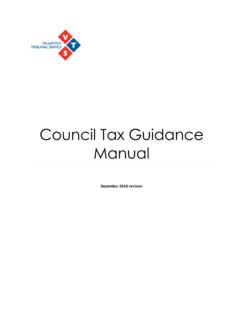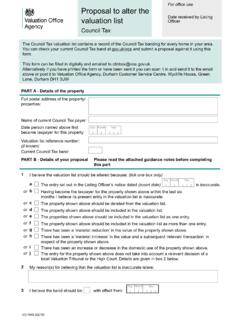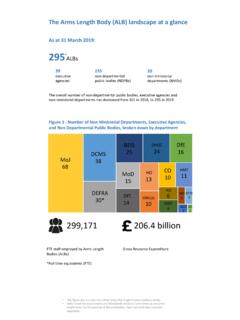Transcription of VOA 2017 Compiled Rating List Data Specification
1 Page 1 of 73 Crown Copyright VOA 2017 Compiled Rating List Data Specification Contents Part one - About this guide .. 3 Background .. 3 Introduction .. 3 Record 3 APIs .. 3 Part two - Compiled Rating list entry data .. 5 List entry data explained .. 5 Reference number and address .. 5 Rateable value and effective date .. 5 Descriptions, special category codes and valuation scheme references .. 5 valuation 5 Current vs historic list entries .. 6 List entry data items .. 6 Field content .. 6 List entry data items (historic entries).
2 8 Field content .. 8 Part three - Weekly change-updates .. 11 Change-update data explained .. 11 List entries .. 11 Additional fields present in list entry change-updates .. 11 Summary valuations .. 11 Change-update list entry data items .. 12 Field content .. 12 Part four - Compiled Rating list summary valuation data .. 15 Summary valuation data explained .. 15 Overview .. 15 Technical Arrangement .. 15 Summary valuation data items .. 16 Record type 01 - Rating list details .. 16 Record type 02 - Line items (multi line).
3 19 Record type 03 - Additional items (multi line) .. 20 Record type 04 - Plant and machinery .. 21 Record type 05 - Car parking .. 22 Record type 06 - Adjustments (multi line) .. 23 Record type 07 - Adjustments totals .. 24 Appendix 1 - Billing authority codes .. 25 Page 2 of 73 Crown Copyright Appendix 2 - Special category and primary description codes .. 37 Appendix 3 - Appeal/proposal settlement codes .. 68 Appendix 4 - Other additions .. 69 Appendix 5 - Reason for change codes .. 72 Appendix 6 - Case type codes.
4 73 Page 3 of 73 Crown Copyright Part one - About this guide Background valuation Officers are required by law to periodically compile and maintain a local Rating list for each Billing Authority. In england and Wales there are currently around 350 billing authorities. The 2017 Rating list was Compiled on the 1st of April 2017, and the next is due to be Compiled on the 1st April 2022. After compiling Rating lists, valuation Officers are required to send copies to each Billing Authority. Subject to our restricted use license terms and conditions, the valuation Office Agency also provides copies of it's Compiled 2017 list free of charge to the public.
5 This guide covers that provision. Introduction There are typically around 2 million properties shown in English and Welsh local Rating lists at any one time. Over the life of a list some properties will come and go, whilst other may see changes made to their descriptions and addresses, and of course to their rateable values with effect from specified dates. Every entry in a Rating list includes a rateable value. Around 80% of our rateable values are supported by a regular site and building survey. The remaining 20% use more specialised surveys, or are based on construction costs or annual accounts.
6 We refer to properties that we are able to value using a regular survey as one belonging to a "bulk" class. This is because we are able to value such properties in bulk. Bulk class properties are typically properties that, at the time of valuation , are in use as shops, offices, warehouses and factories. They also include some land, land used for storage, and some miscellaneous uses that also lend themselves to bulk valuation techniques. Where we use bulk valuation to produce a rateable value we are able to provide a summary of the valuation in our downloadable datasets.
7 The only exceptions are summary valuations that we must suppress for reasons of privacy and security. This guide explains both the dataset containing list entries and the dataset containing summary valuations. In addition, it provides appendices of supplementary information regarding some of the codes and text that appear in both. If you need help with this guide or the subjects covered within, please email us at Record formats All records in our Rating list datasets are held using the same record format. Files are ASCII text files comprising variable length fields delimited by an asterisk.
8 The files have an extension of csv . Records are separated by a Carriage Return/Line Feed. No data items should contain an asterisk. APIs Our use of cloud technology enables users to interact with our downloads using APIs. This provides users with the opportunity to monitor our downloads for change and obtain copies automatically. Page 4 of 73 Crown Copyright Two types of API are available. HTTP based ReST APIs for maximum interoperability, and .NET APIs specifically for MS developers. Advanced users and developers are referred to the MS documentation concerned.
9 For information, the ReST API command that returns an xml document listing all our available Rating list downloads and their last modification timestamp is: The command may be pasted directly in the address bar of web browsers. Some web browsers display xml documents differently to others. Page 5 of 73 Crown Copyright Part two - Compiled Rating list entry data List entry data explained Rating list entries are used by billing authorities to calculate rates bills. Entries are made of several sections, each one performing a particular role as follows: Reference number and address These two data items are used to identify the unit of property, (known as a Rating hereditament), that the remainder of the list entry relates to.
10 Whilst the BA Reference Number is currently displayed in Rating lists, you should use the VOAs Unique Address Reference Number, (UARN), instead. Hereditaments persist across lists. They are shown in both Rating and council tax lists whenever they meet specific conditions requiring them to be shown in one or other or both. Over time, a hereditament will have accumulated multiple entries shown in multiple lists. You can find the full definition of a Rating hereditament in the Local Government Finance Act 1988 section 64, and the specific conditions Rating hereditaments must meet each day to be shown in a Rating list in section 42.


